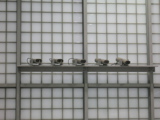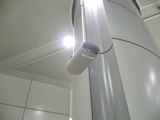![]()
Opticon is a 15-minute audiovisual performance on the theme of surveillance cameras and mobile communications. In this work, four fixed cameras (network cameras) and four performers using mobile cameras (FOMA, a cellular phone technology with video conferencing functions) take visual transmissions that are digitally processed by 10 computers, then fed to a video switcher, four video projectors and a PA system. The result is an audio and visual presentation with the semblance of a story. Opticon was shown on November 11, 2004 as a related event at the VSMM International Conference in Softopia Japan (Ogaki City, Gifu).
![]()

In 1791, the utilitarian philosopher Jeremy Bentham published Panopticon, presenting the concept of a prison in a circular building. Originating from Greek words pan (all) and optikos (of the eye, of vision), Panopticon was designed as a prison laid out in a circular loop, in the center of which would be a watchtower. It was a facility conceived to have perfect observation over all prisoners. Later, post-structuralismÅfs representative philosopher, Michel Foucault, published his 1975 work, Discipline and Punish: The Birth of the Prison in which he employs the concepts of Betham's Panopticon to uncover the administratively controlled social system. That is to say, the possibilities of surveillance gave birth to a self-regulating system that, moreover, is far stricter than any society ruled by external authoritarian power.
In todayÅfs society, there are innumerable surveillance devices being deployed. From theft and disaster prevention surveillance cameras set up on the street and in stores to reconnaissance satellites that orbit beyond the atmosphere, we are living in the middle of a global surveillance network. We could add to this the paparazzi-like mass media coverage. At the same time, it doesnÅft stop at the authorities. Surveillance devices are disseminating to individuals and households. ItÅfs hardly rare to find residents themselves proactively installing surveillance devices. Moreover, digital cameras and video conferencing cellular phones, home security systems, network cameras, internet message boards, weblogs, etc. are functioning as new forms of surveillance devices. Those under surveillance are themselves conducting surveillance, exceeding the self-regulation Bentham and Foucault had indicated.
Of course, in Bentham's and Foucault's Panopticon it is of little importance whether surveillance is actually conducted. It is the possibility of surveillance that is important, and the obscurity of surveillance makes authority transparent, further strengthening self-regulation. This is the same in contemporary society, and so there is no need to keep each of the vast number of surveillance devices watching over people. Recorded images are destroyed regularly, and dummy cameras with no recording capabilities work just as well. One might even say that functionally, personal surveillance is more active than organized surveillance. Regardless, there is clearly a situation in which an unfathomable amount of information is swirling back and forth, amassing. The question of whether something might be born from within that vast information is the point of departure for this work.
The title of the project is Opticon, which is Jeremy Betham's Panopticon without the prefix pan. In short, it is based on the expectation that from this work, in which only localized visual transmissions are focused on, it would be simple to imagine the contemporary state of global surveillance. Actually, we do know that there are innumerable surveillance devices out there, and good public citizens would hardly take notice. One could even say we have gotten too used to constant surveillance. By reexposing the recording devices and display units that carry out the functions of surveillance, this work tries to illustrate a cross section of contemporary society.
In Opticon, four situations emerge in about 15 minutes of play. There is the collection of multiple perspectives, the disturbance of the event through the manipulation of time, the mobility and proximity of vision, and the collision between subject and audience. However, in any of the situations, the display units (or the viewer) are the focal points, and the spatial and temporal positions of the recording devices (or the photographers) are merely changing. Yet, if one carefully observes the events shown by the images, one can see signs of various inconsistencies and confusion that arise. The audience then sees through the manipulation, grasps the surrounding situation, and determines the following actions.
The scene that Opticon paints can only be from the contemporary social environment in which we all live. To grasp the situations of various places without having to go anywhere will broaden the observersÅf perceptions, lifting them to transcendence. Enjoying this perceptual euphoria, it is simple to watch the streaming scene in aloofness. This is the point of view from the audience that watches the performance Opticon. If this work is a cross section of contemporary society, then it is possible that the performance audience adjusts their perceptions of the scene before them when they make the transition from audience member to participants in real society.
In short, our situation today is that of massive amounts of information traffic that vastly exceeds the capacity of any one human being. It no longer becomes a matter of someone watching someone else. Of course, privileged surveillance control has been superior from times before, but complete surveillance has reached a point where it no longer has meaning because explosive increases of information are continuing. In what is this situation perceived, what meaning kind of will be discovered, how does it behaveÅ\these are challenges that emerge from Opticon.
The production starts in the dark, after the title and staff credits have been displayed. A slowly cycling bass tenuto resonates, and as if in response to the sound, distant views of the building where the venue float up as images. The images are lined up on the wall of the venue by four projectors. The views of the building switch out as the angles change. Finally, as the bass cycle shortens, the images change faster, and flicker like flashes in the thunderous sound.
Suddenly the thundering ceases, and the images change perspective to the surveillance cameras inside the building. The scenes are the view from the observation deck on the top floor, the bottom floor entrance and lobby, and the corridors near venue. In the faintly heard weightless music, the surveillance cameras continue to be projected, showing the state of the building outside the venue.
Suddenly, energetic music plays again and the images switch to a distant view of the building. Here, the images that appear to be shot from fixed cameras begin to move, and the images gradually approach the building. It becomes clear that the images are being taken from mobile cameras held by four performers. When the mobile cameras enter the building, the scene switches to the surveillance cameras, and the actions of the performers can be observed.
The surveillance cameras also show people leaving and trying to enter the venue, conveying in reality a connection between that within and without the venue. Yet, looking carefully at the images, one would notice that identical people are appearing in several places at the same time. This is the replaying of images filmed before under an identical situation. An eerie sensation rises that reality and fiction are merging. Within this kind of chaotic situation being shown, the performers gradually approach the venue, raising tensions.
When the performers enter the venue, the images switch to only those of the mobile cameras, and the music changes to an increasing strained melody. Inside the dim venue, the performers shine white light LED flashlights as they continue to transmit images. People and objects are viewed from the various perspectives of four mobile cameras, and shown on the same venue wall. The images from the mobile cameras have different timing and occasionally there is some block noise in the rough images, but this gives the scene a sense of intensity and reality.
As the performance comes to a close, the image is slowly crossfed, and the scene of a train station a few kilometers away appears. In front of the station, a large image billboard plays the image of the mobile cameras. The music changes to a mild melody. The situation of the station scene being played is a synthesized image, but it would be difficult to make that distinction. Finally, the image and music feed out, and in the dark silence the work comes to an end.
1. The four fixed cameras are WEB server capable network cameras that are set up in four different places in the building where the venue is. The fixed cameras are connected to the LAN in the building, and four computers connected to the same LAN take the images. The network camera images are displayed on the web browser, but in order to display the camera image in full screen, an image enlarger utility is applied.
2. The four mobile cameras are cellular phones (FOMA) with video conferencing functions. Each performer uses one camera. Four phones of the same kind are set up to receive the transmission. The images from the mobile cameras are taken with a computer from the video output of these phones through a video converter. To project only the video image from the cell phone screen, an independently developed program is used. Also, this program is capable of movie replay, image synthesis, and luminosity control.
3. The eight computers used to display the images from the fixed and mobile cameras output the full screen video images in analog video signals. The eight different analog video signals are input into a video matrix switcher, then output from the video switcher to four projectors. Therefore, eight different camera images can be put together at will, and projected from the four projectors.
4. The image control computer controls the video switcher through a serial port from a USB serial adapter connected to the USB port. This computer also controls the computer connected to the mobile cameras through Ethernet. These controls are half automated, but the operator makes impromptu changes according to the development of the performance.
5. The audio control computer, generates music and audio effects in real time, sends volume and timing information through Ethernet, and controls the image control computer and the computer connected to the mobile cameras. The operator at the audio control computer carries out the entire performance.
Fixed Cameras (Network Cameras): Panasonic
BB-HCM1, Panasonic BB-HCM311, AXIS 205, AXIS 200+
Mobile Cameras (Visual Phones): FOMA P900iV(x4), SH900i, F900i,
P900i, N2102V
Computers for fixed cameras: Dell Precision M80(x2), Latitude D600(x2)
Computers for mobile cameras: Apple PowerBook G4/1.33GHz(x2), PowerBook
G4/1GHz(x2)
Computer for Visual Control: Apple PowerBook G4/800MHz
Computer for Audio Control: Apple PowerBook G4/1GHz
Video Switcher: Sony PVS-880S
Video Converters: Canopus ADVC-300(x2), Sony DVMC-DA1, Formac Studio TVR
Ethernet Hubs: Buffalo LSW10/100-8HW(x2)
USB-Serial Adapter: Keyspan USA-28X
Audio Interface: Roland FA-101
Audio Mixer: Mackie 1202-VLZ Pro
Power Ampifiers: d&b audiotechnik P1200A(x2)
Loud Speakers: d&b audiotechnik E3(x2)
Subwoofers: d&b audiotechnik E15-BX(x2)
Programming Language: Cycling'74 Max/MSP/Jitter
And: White LED Lights(x5), Several Cables, Tables/Stands
Kanao Yamaoka : Visual Programming
Yuta Nagashima : Audio Programming
Yoko Shirai : Performance
Ken Shibabe : Performance
Yuichi Nakamura : Performance
Hiroshi Takashima : Performance
Chie Terashima : Assistance
Sumiko Izawa : Assistance
Reona Ogura : Assistance
Yoshihisa Okano : Assistance
Yukiko Ina : Video Documentation
Akio Ito : Video Documentation
Yuko Nishikawa : Video Documentation
NTT DoCoMo Tokai
The Tokio Marine Research Institute

